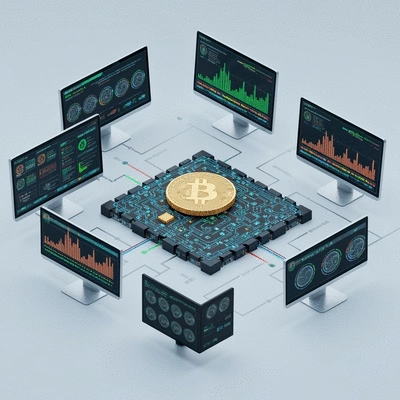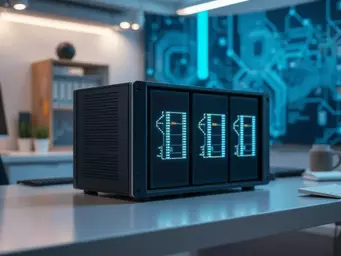Bitcoin Network
The global, interconnected system of nodes that collaboratively secures and maintains the blockchain, validating transactions worldwide.

As Bitcoin continues to evolve, understanding the intricacies of mining is essential for anyone interested in cryptocurrency. With emerging technologies and trends shaping the future, now is the perfect time to delve into what mining means for the ecosystem.
Delve into the fundamental elements that drive Bitcoin mining, from its foundational network to the metrics that define its computational power and rewards.
The global, interconnected system of nodes that collaboratively secures and maintains the blockchain, validating transactions worldwide.
Measures the total computational power miners use to solve proof-of-work puzzles, directly impacting network security and mining efficiency.
The Bitcoin earned by a miner for successfully validating a block of transactions and adding it to the blockchain.
The cryptographic puzzle miners solve to validate transactions, ensuring network security and preventing double-spending.
Bitcoin mining is a fascinating aspect of the cryptocurrency world that plays a crucial role in maintaining the integrity and security of the Bitcoin network. In 2025, understanding Bitcoin mining goes beyond just knowing how it works; it's about grasping its significance in the ever-evolving landscape of digital currency. Let’s dive into the basics of Bitcoin mining and what you need to know to get started!
At its core, Bitcoin mining involves the process of validating transactions on the Bitcoin blockchain. Miners use powerful computers to solve complex mathematical puzzles, a method known as proof-of-work. This process not only ensures the security of transactions but also adds new blocks to the blockchain. The Library of Congress provides a comprehensive overview of cryptocurrency and blockchain technology, which further explains the foundational concepts.

To grasp how this works, think of it as a competition among miners to solve a puzzle. Once a miner successfully solves the puzzle, they verify the transactions and are rewarded with newly created bitcoins and transaction fees. This continuous validation process keeps the Bitcoin network running smoothly, ensuring trust and transparency!
Understanding these fundamental principles is essential for anyone looking to enter the world of Bitcoin mining, whether you're a newcomer or someone exploring the possibilities of cryptocurrency!
As we look ahead to 2025, Bitcoin mining remains a relevant and critical component of the cryptocurrency ecosystem. The ongoing significance of mining can be attributed to several factors, including the increasing adoption of Bitcoin and the evolving technological landscape. For more details on the economic and legal aspects of Bitcoin, the University of Richmond's scholarship on Bitcoin's implications offers valuable insights.
Emerging trends show that miners are now focusing on efficiency and sustainability. Many are exploring renewable energy sources to power their mining operations, which not only reduces costs but also addresses environmental concerns. This shift in focus is vital as more people become aware of the environmental impacts associated with traditional mining practices.
These trends signal a bright future for Bitcoin mining, shedding light on its potential to adapt and thrive in a rapidly changing digital landscape!
To fully understand Bitcoin mining, it's important to familiarize yourself with a few key concepts. The Bitcoin Network is an interconnected system of nodes that collectively manage the blockchain. This network ensures the validation and security of transactions across the globe.
The hash rate refers to the computing power used by miners to solve the proof-of-work puzzles. A higher hash rate means that miners can solve puzzles more quickly, resulting in increased chances of earning rewards. Speaking of rewards, the mining reward is the amount of Bitcoin a miner receives for successfully adding a new block to the blockchain.
Understanding these concepts will empower you to navigate the world of Bitcoin mining with confidence!
Now that you have a grasp of what Bitcoin mining is all about, let’s talk about how you can get started. As a beginner, setting up your mining operation can seem daunting, but with the right guidance, you can tackle it step by step. Are you ready to dive into the essential setup steps? Let's go! For a beginner's guide on how to mine Bitcoin, CoinTelegraph provides an excellent resource on mining BTC.
Did you know? To maximize your Bitcoin mining efficiency, consider joining a mining pool. By collaborating with other miners, you can combine your resources and increase your chances of earning rewards more consistently. This method not only enhances your mining potential but also helps mitigate the risks associated with mining solo!

Bitcoin mining is the process of validating transactions on the Bitcoin blockchain using powerful computers to solve complex mathematical puzzles (proof-of-work). This secures the network, prevents double-spending, and adds new blocks to the blockchain.
Proof-of-work is the cryptographic puzzle that miners compete to solve. The first miner to find the correct solution gets to add the next block of transactions to the blockchain and receive a reward.
The hash rate measures the total computational power that miners contribute to the Bitcoin network. A higher hash rate indicates greater network security and more competition among miners.
A mining reward is the amount of Bitcoin a miner receives for successfully solving a proof-of-work puzzle and adding a new block of validated transactions to the blockchain. This reward includes newly minted Bitcoin and transaction fees.
Sustainability is crucial due to the significant energy consumption of Bitcoin mining. Adopting renewable energy sources and energy-efficient hardware helps reduce the environmental impact and addresses growing concerns about carbon footprint.
Decentralization ensures that no single entity controls the Bitcoin network. This promotes security by making the network resistant to attacks, enhances transparency, fosters fair competition among miners, and builds a resilient community.
Future innovations include more energy-efficient ASIC miners, potential applications of quantum computing for faster algorithms, AI-driven optimization of mining operations, and increased reliance on alternative energy sources like solar and wind power.
As we look towards the future of Bitcoin mining, it's clear that innovations and sustainability will play a significant role. In my journey with How Does Bitcoin Work, I've seen how technology evolves rapidly, and mining is no exception! Keeping an eye on upcoming technologies and trends can help you stay ahead of the curve.
In the coming years, we can expect advancements in mining hardware, algorithm improvements, and energy-efficient solutions that could revolutionize how we mine Bitcoin. This not only impacts profitability but also aligns with the growing demand for eco-friendly practices.
Several exciting developments are on the horizon for Bitcoin mining. Here are some key technologies and trends to watch out for:
These advancements not only promise to make Bitcoin mining more accessible but also more sustainable—an essential factor for future operations!
With the increasing scrutiny on Bitcoin mining's environmental impact, adopting sustainable practices has never been more crucial. As I share insights through How Does Bitcoin Work, it's evident that miners must take responsibility for their carbon footprint.
Here are some eco-friendly practices that can help mitigate the environmental impact of mining:
By adopting these practices, we can work towards a more sustainable future for Bitcoin mining and its community, making it a responsible choice for newcomers.
Decentralization is at the heart of the Bitcoin network, and its importance cannot be overstated. As a passionate advocate for cryptocurrency education, I believe understanding decentralization will help future miners appreciate their role in the ecosystem.
Here are some reasons why decentralization will continue to shape mining practices:
As we move forward, embracing decentralization will be crucial for maintaining the values that Bitcoin was built upon, fostering a strong and empowered mining community.
Here is a quick recap of the important points discussed in the article:
Understanding Blockchain Security Basics

As the world evolves rapidly in the realm of cryptocurrency, understanding the intricate security me
Understanding Blockchain Nodes Simply

Ever wondered how transactions maintain integrity in a decentralized world? The answer lies in the e
Understanding Blockchain Security Basics
Create a blog post title that is 5 words or less for a post that is about the following "Bitcoin Mining Software Comparison: Features and Setup Guides" Please avoid superlatives. Please avoid the futuristic, superlative, robotic-type language. provide the title only and no other details.
Understanding Blockchain Nodes Simply
Set Up Your Bitcoin Wallet
Choosing the Right Bitcoin Wallet